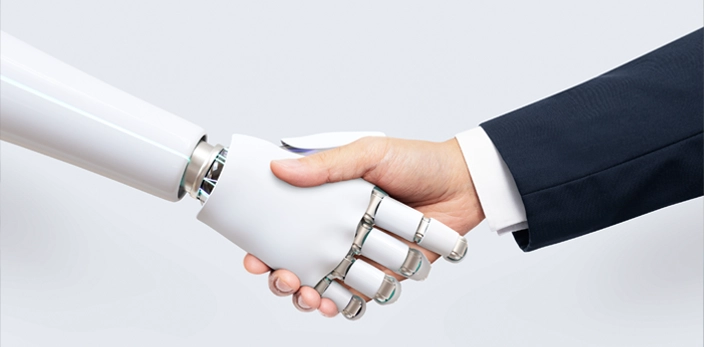Human and AI in L&D and assessment can go hand-in-hand. But with the demand for increased efficiency and better strategy, and with the trend heading towards AI, is there still space for humans in human resources?

Using artificial intelligence (AI) in businesses can create trillions of dollars for the global economy. This explains the increasing trust and adoption of AI technology by global businesses. In the middle of these changes, one heavily affected team is the human resources (HR) department.
From the name itself, human resources is a team of humans dedicated to human capital. Yet to respond to the demand for increased efficiency and better strategy, shifting to technology is unavoidable. Technology, including AI, improves processes from talent acquisition to employee retention. So if the trend continues to head toward AI, will there still be space for humans in human resources?
A Closer Look at AI Adoption
While there is a strong potential for AI, global adoption lags. McKinsey infers that developed countries will be able to adjust to this faster due to higher wages that create better economic feasibility to adopt automation–but are they willing to?
Deloitte’s State of the AI in the Enterprise Report for 2023 mentions the “human-machine collaboration strategy.” And this is something companies might relate to. One of the reasons why global adoption is slowing down in recent years is because of this.
Job loss, changing roles, technology taking over–these are employee concerns we are all too familiar with, especially during the rise of automation years ago.
Change management is not a new topic in the technology integration conversation. However, times have changed. Employees have become more open to integrating new tools. Now, it is up to leaders to properly manage complementing ways of working.
With confidence in AI increasing, leaders must redesign their processes and systems for human and technology collaboration. Enough support and training must be given to employees to maximize the use of technology, because although technology is here to stay, so will humans.

Understanding AI in Recruitment and Employee Training
AI is revolutionizing the way organizations work. With the popularity of AI-driven solutions, it is crucial to consider the role of human interaction in this landscape.
An IBM report provides insight into how AI reshapes businesses, particularly HR processes. In 2022, HR professionals occupy the 9th spot among the top 10 users of AI in organizations. The top users are predominantly in technology professions such as IT professionals, data engineers, developers, and data scientists. HR is among the few non-tech-related departments on the list.
Looking into how organizations use AI, 45% attribute their usage to improve recruiting and human resources. Additionally, 50% use it to increase employee learning and training.
The results are unsurprising given the massive effort to utilize technology in the war for talent. Constant screening and upskilling talent were required to keep businesses running during the pandemic. Technology already penetrated HR even before the AI conversation became popular again. Nowadays, business leaders are fully aware of the value technology brings to HR.
Finding the Place for Human Interaction in the AI Landscape
For the past few years, businesses have opened their doors to geographically-dispersed teams. This resulted in the rise of remote work and global recruitment. In the process, ensuring communication and collaboration has become imperative.
Regardless of the native tongue and location, everyone should speak the corporate language. From recruitment to retention, language and communications skills is the new HR priority.
In recruitment, HR teams rely on AI for assessment for a faster and easier hiring process. But remember that AI, no matter how powerful, is at a low level compared to its potential.
AI, in its infancy currently, requires careful use. That is why it is important not to eliminate human judgment in the screening process.
HR teams can effectively leverage AI while still valuing human interaction and judgment. For example, the power of adaptive placement exams might be in evaluating grammar and comprehension skills. But communication abilities especially speaking skills is something only humans can effectively assess.
For training and development, new tools are available because of eLearning. Adaptive learning systems utilize AI to assess students’ strengths and weaknesses. This allows personalized and tailored content delivery.
In addition, automated assessment tools streamline grading processes, reducing administrative burdens for HR managers. These advancements allow for easier training deployment. Yet looking into what drives engagement in L&D programs, there is still no substitute for human interaction.
Going digital enables personalized learning. However, it is through human interaction (like in coaching and social learning) that knowledge is applied and maximized.
Human connection fosters emotional engagement, promotes critical thinking, and nurtures creativity. Human trainers, whether face-to-face or online, go beyond delivering content. They inspire, motivate, and mentor learners.
Human interactions provide a supportive environment. It enables learners to ask questions, engage in discussions, and collaborate with peers. Human trainers possess the expertise to identify non-verbal cues, emotions, and individual learning styles, which can impact learners’ growth and development.
Having both human and AI in L&D and assessment provide advantages– so is it truly necessary to have only one or the other?

Keeping the Human in Human Resources
When it comes to humans and AI in L&D and assessment, it is ultimately the former that unlocks the latter’s potential. HR professionals and leaders must find the right balance of technology and human interaction to achieve their goals.
goFLUENT, the world’s leading language solutions provider, anchors its products and services on the belief that human interaction is indispensable in learning and assessment. Even with over 20 years of harnessing digital transformation for HR solutions, human interaction remains part of its core.
goFLUENT’s cutting-edge AI-powered eLearning platform, Corporate Language Academy, personalizes the learning experience and recommends training content depending on the learner’s language level, position, and interest. But part of the learning solution is human trainer-led language classes in the virtual classroom of the platform.
Whether in a group or one-on-one, written or spoken communication, learning is maximized by offering lessons from expert trainers.
Recently, with the launch of its language proficiency assessment solution, goFLUENT remains true to its DNA. Language Assessment combines the strength of AI and human assessment. The AI adaptive technology allows fast and seamless testing of language skills. And human assessment removes bias and ensures accurate evaluation of language skills based on CEFR.
goFLUENT understands that the adoption of AI is inevitable. Embracing these technologies in processes is what will bring organizations to greater heights. But as companies transition, humans should remain their most significant investment and asset.
In AI-driven recruitment and L&D space, humans remain the key to creating lasting impact. Their emotional intelligence and ability to connect with others are invaluable qualities that cannot be done by AI alone. Therefore, there will always be a space for human involvement in shaping the future of human resources. It is dedicated to developing and empowering your most valuable strength – your human capital.
A previous version of this article was published on OEB Insights.



